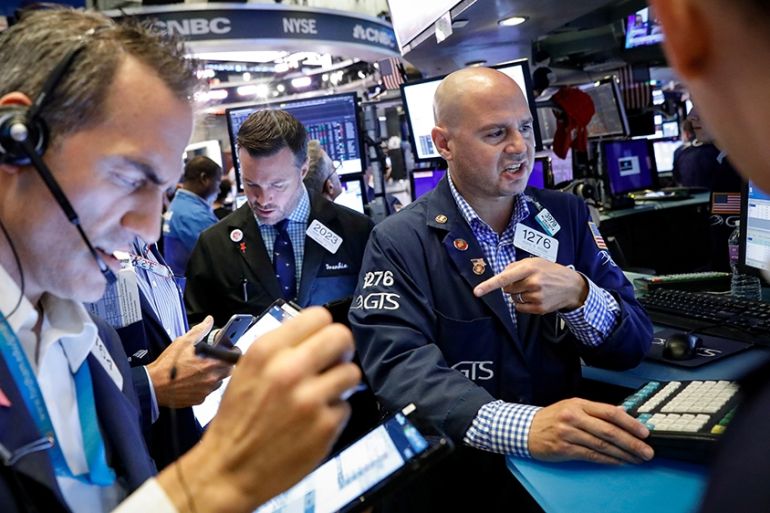Double punch: Markets fall due to US jobs data and trade war
The US President this week announced a fresh round of tariffs on $300bn in Chinese goods – and China vowed to retaliate.

After China vowed to retaliate against a possible new round of tariffs announced by United States President Donald Trump, a measure of stocks across the globe posted on Friday its largest weekly loss of the year, while yields in US and German debt were near or at multi-year lows.
Oil prices bounced back from losses that exceeded seven percent the previous session, and the yen scaled further against the dollar a day after its strongest daily gain in more than two years.
Keep reading
list of 4 itemsStocks slide on Middle East tensions as hope crisis contained stems losses
As US inflation ticks back up, it could impact the presidential election
Will the US unemployment rate continue at historic lows?
The moves followed a sharp Wall Street selloff triggered by Trump’s threat Thursday to impose a 10 percent tariff on $300bn worth of Chinese imports.
China did not specify how it would retaliate, but its ambassador to the United Nations, Zhang Jun, said Beijing would take “necessary countermeasures” to protect its rights and bluntly described Trump’s move as “an irrational, irresponsible act”.
Analysts have said retaliatory options include tariffs, a ban on the export of rare earths used in everything from military equipment to consumer electronics, and penalties against US companies in China.
The trade war between the world’s largest economies has already dislocated global supply chains and slowed economic growth. The abrupt escalation capped a critical week for global markets after the US Federal Reserve delivered a widely anticipated interest rate cut but played down expectations of many more ahead.
“The tariff threat was a splash of cold water,” said Michael Antonelli, market strategist at Robert W Baird in Milwaukee. “The market had become accustomed to the current state of US-China trade negotiations, but a hike in tariffs wakes you up to the fact that the trade war is still with us.”
The Dow Jones Industrial Average fell 98.41 points, or 0.37 percent, to 26,485.01; the S&P 500 Index lost 21.51 points, or 0.73 percent, to 2,932.05; and the Nasdaq Composite dropped 107.05 points, or 1.32 percent, to 8,004.07.
The Wilshire 5000 Total Market Index of US stocks lost $1.1 trillion in market capitalisation over the week.
The pan-European STOXX Europe 600 Index lost 2.46 percent, the most for any day this year, and MSCI’s gauge of stocks across the globe shed 1.18 percent.
Emerging market stocks lost 2.03 percent and posted their ninth-straight session of declines, while futures in Japan’s Nikkei Index lost 0.71 percent.
More Fed cuts seen
US data on Friday showed employment growth in July slowed as expected. This, along with trade turmoil, may encourage the Federal Reserve to cut interest rates again in September.
“On balance, it is probably a slightly dollar-negative (employment) number because (it) increases the case for a Fed rate cut in September. We’re already at the point where we’re trading that,” said Greg Anderson, global head of foreign exchange strategy at BMO Capital Markets in New York.
A further 25-basis-point cut by the Fed is priced in for the central bank’s September meeting, while the chance of another cut in October is roughly three in five, according to Fed futures markets.
Safe-haven assets were bid across markets with German 10-year government bond yields dropping to an all-time low of -0.502 percent and the country’s entire government bond yield curve turning negative for the first time ever.
Benchmark 10-year notes last rose 14/32 in price to yield 1.8434 percent, from 1.892 percent late on Thursday. This week yields touched their lowest since Trump’s election in November 2016 and the benchmark posted its largest weekly drop since 2012.
“In the grand scheme of things, it will become clearer and clearer that the Federal Reserve has started an easing cycle and will have no choice but to cut rates further,” said Akira Takei, fund manager at Asset Management One.
In currency markets, the Japanese yen, which on Thursday gained the most in over two years against the dollar, further strengthened 0.73 percent to 106.59 per dollar.
The Swiss franc reached a two-year high of 1.0906 against the euro, which bounced back from a two-year low of $1.1025 earlier in the week.
The common currency was recently up 0.2 percent to $1.1105.
The British pound held near a 30-month low versus the dollar as the governing Conservatives‘ majority in parliament was reduced to one seat, three months before the country is due to leave the European Union.
Sterling was last trading at $1.2164, up 0.27 percent on the day.
US crude rose 2.35 percent to $55.22 per barrel and Brent crude was last at $61.30, up 1.32 percent on the day.